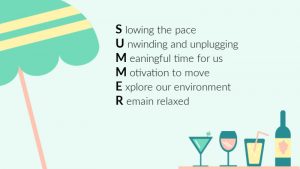by virtualworks | Jun 20, 2023 | daily lfe, Mastery, Time Management, Uncategorized
 Summer officially arrives tomorrow, Summer Equinox and the longest day of the year. Some of us may head off to the beach or a cottage, some may be working in the heat of summer, while still others may be getting comfortable near a fan. As noted in the acrostic above, summer is an opportunity for us to do a few things to keep ourselves calm and relaxed as we unwind this summer.
Summer officially arrives tomorrow, Summer Equinox and the longest day of the year. Some of us may head off to the beach or a cottage, some may be working in the heat of summer, while still others may be getting comfortable near a fan. As noted in the acrostic above, summer is an opportunity for us to do a few things to keep ourselves calm and relaxed as we unwind this summer.
Slowing the pace
By taking the time to stop what we’re doing, or interrupt the daily cycle to listen, take a breath and live in the moment, even for just a minute, we can gain tremendous benefits such as lowering stress levels, lowering our heart rate and improving our mood and psychological engagement. Lifehack.com has a list of ways to slow down in a fast-paced world.
Unwinding and unplugging
Try going a day (or longer) with no technology, the magic of un-plugging. That means no phone, no television, no media of any kind. Instead, why not try taking a relaxing bath, read a good book (made from an ancient fibre called ‘paper’), playing music or painting, or any other activity one would consider “old school”. By taking note of how you feel at the end of the day or more with no technology and noting if you had an unwound day without it. Getting in touch with some of the old ways of doing things can make a difference in one’s day and it can actually help you feel mentally refreshed. A colleague mentioned when she needs to unwind, she bakes some bread but doesn’t use machines to make it. Just a bowl, spoon and her two hands. She swears by it as a stress reliever.
Meaningful time for us
Don’t feel guilty about taking some much-needed quality or meaningful time out just for you. How we define that time may be different for everyone. Perhaps it means to be alone to collect your thoughts without interruption, or it may mean making time for family and friends. Just remember to not feel guilty about taking that time back but if you need some convincing on why it is important to take the time for yourself, Psychology Today runs through a few reasons to not feel guilty about solitary time for you and Time.com talks about the importance of meaningful time with those around us.
Motivation to move
So far, we have talked about slowing down, unplugging, unwinding and taking time for ourselves. This all sounds pretty relaxing, but what about the importance of getting up and moving? While this almost feels counter-intuitive to the strategy of relaxing, exercise can make that relaxation all the more impactful by adjusting our body chemistry to reduce stress and boost mood, allowing us to better make use of our previously discussed methods for relaxation, as mentioned in Harvard Health. Alternatively, if the heat has got you down, taking a dip in the nearest pool or lake is another great way to stay in shape.
Explore our environment
While you’re getting up to exercise, why not take it outside. It’s summer after all! This gives you a wonderful opportunity to mindfully take in nature within your neighbourhood, or local trails. In our busy days, we don’t always get to take in the beauty of our environments.
Remain relaxed
Finally, some days just feel like chaos rests at the top of our minds. This is the perfect chance to try some meditation exercises to quiet the chaos, reduce stress and bring us back to that place where we can once again enjoy a slower pace by unwinding and making our summer a meaningful one.
Have a wonderful summer everyone!
by virtualworks | Jan 2, 2023 | Accomplishments, business growth, daily lfe, holiday, Leadership, Mastery, office management, Team Work, Time Management, working from home, working remotely
 These last few weeks can be labelled as busy, chaotic, and exhausting and I’m not even talking about work! I’m talking about the holiday time off that just passed! While I am glad to be back at work, it’ s tough to get back into the routine again. On that note, I hope you have all had a wonderful, stress-free holiday. For those that are perhaps not feeling the back to work grind, I offer the information below.
These last few weeks can be labelled as busy, chaotic, and exhausting and I’m not even talking about work! I’m talking about the holiday time off that just passed! While I am glad to be back at work, it’ s tough to get back into the routine again. On that note, I hope you have all had a wonderful, stress-free holiday. For those that are perhaps not feeling the back to work grind, I offer the information below.
Whether you had a relaxing time off, or you still need a vacation from your vacation, the transition back to the day-to-day routine of work, without the distraction, food and fun of the holidays is no easy task. So, first thing’s first: don’t be too hard on yourself, we’re all a little rusty getting back into the swing of things.
At times people may experience depression, the “winter blues” and anxiety. With winter settling in and the excitement of the holidays over, we push ourselves back to work and may not always recognize when it is time to take care of ourselves.
Don’t forget if you do need help right away the Canadian Mental Health Association has resources available.
A couple of years ago CBC posted an article on the anxiety of returning to work after the holidays and what you can do to manage it.
The signs of the “Winter Blahs” can include:
- Lack of motivation and loss of interest;
- Low energy;
- Difficulty sleeping; and
- Difficulty concentrating
However, there are a few ways to manage this form of depression that tends to linger during the winter months, so why not give some of these a try!
- LIGHT THERAPY:Use of an artificial light source, as light therapy to create the sunlight you would otherwise get during the summer months.
- SMALL ACCOMPLISHMENTS:Boost your motivation by completing small manageable tasks, recognizing each task as an accomplishment and step to a larger goal.
- HEALTHY EATING:Foods that contain the minerals and nutrients to get you through your day not only impact your physical health but can also be beneficial to mental health.
- STAY ACTIVE: (my personal favourite) Being active for 30 minutes per day is known to provide a fantastic boost of energy, confidence and provide an overall improvement to one’s mental and physical well being.
- EMBRACE THE COLD:As the winter is tucking itself in for a little while, there is no getting away from it and we may as well embrace it by getting out there and enjoying what it has to offer, such as skiing, snowshoeing, skating and even bundling up for that walk on your own or bring a friend.
So, what about getting used to that routine again? Even if you aren’t feeling the blues, maybe you are feeling the difficulty of getting back to the routine, so give a try with:
- Don’t set yourself up for negativity! – “Be the positive change you need.” I know it sounds a little strange, but taking a positive attitude to go back to work can be an excellent start to going back to work.
- Be ready for the pile of work and chunk it out into steps – sure you have been away from the office for a little while, so you might want to anticipate the pile of work that may be waiting for you.
Slow and steady wins the race:
- Step 1: Make that coffee have a seat
- Step 2: Make a list of the things that need to be completed
- Step 3: Then chip away at it, one thing at a time
- Be patient with yourself.
Bring something to work or do something nice for yourself and ease back into it. Remember it is a new year, so this can be a fresh start to fantastic things to look ahead and look forward to.
You can do it! Wishing you everything wonderful for 2023 from Barbara B. and the team at VWI.
by virtualworks | Nov 19, 2022 | Business, business growth, daily lfe, Mastery, Productivity, working from home, working remotely
 I think it would be an understatement to say there is a lot of information from the news out there, at our fingertips through the newspaper, magazines and the internet, in our ears from the radio and as we sit to relax in front of the television
I think it would be an understatement to say there is a lot of information from the news out there, at our fingertips through the newspaper, magazines and the internet, in our ears from the radio and as we sit to relax in front of the television
Recently a friend of mine told me a story of how her sister was scanning through Facebook and came across an article that causes stress and anxiety for her sister, based on its content and coincidental applicability to events taking place in her life. In an effort to calm her sister she checked out the article discovering that it was not a recent publication and is what is referred to as “click-bait”, where an article provides a shocking title or introduction to lure people to read it and click on a link to another page, which in this case was to sell a product she didn’t need. This particular situation can be related to so many people facing a daily bombardment of information and requires us as consumers of information to ask the right questions.
If there is so much out there that is not reliable, why is news still important?
It is still important to know the facts about what is going on around us to help us make better decisions. This could include the simplest news like the weather person telling us its going to rain, so you make decisions to pack an umbrella, to changes in the stock of a corporation you are currently investing in. Also keep in mind that positive stories are still out there. It can brighten one’s day to read a story of a student who volunteers her time after school to set up activities in her local elder’s residence or community coming together to help out a family
How do we decipher the information coming in and why it is important to look into where news comes from?
When looking at a source of information there are a few best practices in determining the reliability of the information. Some of these can take some time and research, but if someone is really determined to measure the reliability of a source there are a few steps that can be taken. These can be quick checks such as verifying the date of the publication of the article is current, checking who the author is and doing a search of the author to determine if they have credentials in the field they are discussing and verifying the publication source. Further research could be in identifying the company or organization that is publishing this article, are they a known source, are they a source in the related field of the article topic? Finally, another level of research could include determining the organization’s place in the industry and what their best interests would be. For example, if you came across an article stating “Brand X” dog food is known to cause digestive illness in dogs and it is published by a communications division of “Brand Y” dog food, you might question what the motivation would be for this article. Is it to warn people, or have “Brand X” purchasers move over to “Brand Y”, increasing sales?
What responsibility does the reader have in distinguishing fact from fiction?
As the reader we need to watch what is real and what is not to ensure we are looking at information that is correct and to know our limitations in how much to take in, by understanding the cues from our emotions. If something induces a very negative emotion, it may be time to step away from that article, at least for the time being. Which leads us to…
When and why it is time to shut the news off?
As mentioned above, negative emotion can be your internal alarm to let you know when some news might just be enough and it may be important to interrupt the messaging being taken in at that time, to move onto something more productive and positive.
In these days of 24/7 information, give yourself permission to set boundaries around what is good for you and what is not good for you. You and your mental health are important!
by virtualworks | Aug 28, 2022 | Brand Image, Case Study, Customer relationships, daily lfe, Marketing, Mastery, Travelling
 “Before the pandemic, I was making arrangements for my summer holiday to the U.K. Among those many arrangements and bookings I had to make, two stood out in my mind – each of which are a great example of customer loyalty, how to build it and how to lose it quickly.
“Before the pandemic, I was making arrangements for my summer holiday to the U.K. Among those many arrangements and bookings I had to make, two stood out in my mind – each of which are a great example of customer loyalty, how to build it and how to lose it quickly.
The first experience was with a large, well known mail order firm in the U.S. I had purchased travel clothing for my trip and not everything fit well so I had to return a few things. The return slip was easy to complete and advise what I wanted done with the returned items.
Rather than me hunting all over the house for a copy of their catalogue, they included one with the order so it would be easy to find substitutions if I wanted. They included a pre-printed return label within its own folded card with instructions. These few easy to do steps made the return of the clothing really easy and hassle free to the extent that I just had to fill in the sender address on the label, tape up the box and drop off at my local post office. It was almost a joy to return the things I didn’t want. Will I purchase from them again? Absolutely!
The other experience was with a tour operator for an excursion of a now well-known castle in Britain. I had made the booking back in March and I was so happy that the date was available as it was going to be one of my last days in Britain – I really lucked out! I was so looking forward to it even though it was 6 months away.
In May, I received a notice by email that my booking was cancelled and asked what other date would I like to choose? I replied by saying it was the only date I was available for the tour and requested that my money be refunded. I waited a week and sent them a reminder. A couple of days after that, they requested my PayPal account address. A week later I checked my account and there was considerably less money in my account than the original amount I paid. There was no explanation by email for the difference. I researched their website to see if there was a cancellation policy, none to be found. I emailed again advising what I had paid and what I had received as a refund and requested they remit the difference immediately. Will I purchase from them again? Absolutely not! Will I recommend them? Not a chance.
In both these situations, the return process is handled by using a few simple steps to keep the customer (me) happy and coming back. One of them has it perfected; the other has a lot to learn!
Do you have any customer loyalty examples to share that we can all learn from? Please comment and feel free to social share below. Thanks!
by virtualworks | Aug 1, 2022 | Business, business growth, daily lfe, holiday, Leadership, Mastery, Productivity, Time Management
 In a previous blog post, we discussed un-plugging from the virtual world including from media, and from work, as I do in the summer to take some much-needed time off at a cottage in the remote Quebec countryside for a week of peace and quiet. Upon my return, everything is still functioning, even though I’ve taken a full week to un-plug.
In a previous blog post, we discussed un-plugging from the virtual world including from media, and from work, as I do in the summer to take some much-needed time off at a cottage in the remote Quebec countryside for a week of peace and quiet. Upon my return, everything is still functioning, even though I’ve taken a full week to un-plug.
This year though, COVID came for me just prior to leaving so I didn’t do much more than sleep. Usually, though, I spend the entire week reading, knitting and writing. I love to kayak on the lake in the mornings when the water is still. It’s very peaceful and lets me just think about things without all that daily noise in my head. Some might say that I’m downright lazy during my week off. Is that okay? Yes, it certainly is because I deserve it. Do I miss technology when I’m at the lake? No, because I don’t need it there.
For those that are making the attempt to relax and take a break from work and media, but don’t want to travel, a ‘staycation’ may be an option. Whether by themselves or with family in the house there are a variety of ways to relax such as spa-at home days, reading, creative projects, music, further learning or games. No matter what the relaxing activity there are plenty of ideas out there to get the staycation started!
While the suggestions below may require some online research to get started, once the information is found, there is a choice to shut off this technology or enjoy it depending on the person. Maybe they are a true “no tech staycationer” or maybe they “un-plug” while playing online games, watching movies, listening to music and so on.
In the spirit of getting the staycation underway, here are a few resources if you are not sure what to do:
Want to relax in your personal spa? The PennyHoarder has some fantastic ideas for creating materials for a spa at home and as a bonus creating some of these can be considered a little project!
Do you have a creative side and would love to work on something, but are not sure what? DIY Projects has a few ideas to check out. Maybe you just want to enjoy art or music from home, but don’t have access to great works of art or music. Check The Guardian’s list of virtual museums and art galleries, Billboard’s and Glamour’s lists of virtual concerts and performances. Even orchestras have live performances online as listed on classicalfm.
Do you just want to learn something to keep your brain moving or perhaps you miss the library completely? There are a number of open university courses out there to get you thinking and OpenLibrary is an excellent online library if you are just looking for something to read.
Or maybe you want to get up and get moving, take a look at Runtastics 28-day at home workout.
It doesn’t matter how you “un-plug”. What matters is that you bring yourself to a place of relaxation and contentment, while staying safe.
by virtualworks | Jun 6, 2022 | Business, Case Study, Customer relationships, daily lfe, Leadership, Mastery, Outsourcing, Productivity, Time Management

I was in denial. My driveway needed re-sealing for quite a few years and I was really hoping the night fairies would come and do it for me. Alas, no. A couple of summers ago, I thought I’d do it myself: get the bucket of black goo and the roller from the DIY store and spend time in 35C heat rolling said black goo on my 2 cars wide and 2 cars long driveway. I never quite got around to it. I’m not a procrastinator but somehow I always managed to justify my lack of dedication to this part of home ownership.
About a month ago, a young man from 2 streets away knocked on my door and told me that he had a new business re-sealing driveways for the summer. He was studying accounting at university and thought this type of business venture would help him in school. (Great idea!)
I asked him how much to do the job and he said $195 tax in. I had to think about it – that’s quite a bit of money just to roll out a bucketful of black goo. I looked at my dismal driveway and thought woefully how long I had been putting off the task. I called him back to say that I would take him up on his offer. We scheduled the work for the following day.
My hero came over close to supper time the next day and while I was preparing the meal, I checked in on the progress by periodically going back and forth between the kitchen and the living room. The first thing I saw was him power spraying all the weeds out from between the driveway and the curb. I didn’t even think of that. The next trip to the living room I saw him power spraying the entire surface of the driveway. I would have swept the driveway; I didn’t even think of power spraying it. Then he taped off the entire perimeter of the driveway so that no black goo would get on the lawn. After that, he manually filled in all the cracks and holes (there were many). Only then did he roll out the black goo.
By the time he finished, that $195 was the best money I ever spent for value of work. Not only did he save me the labour of doing that type of work in the summer’s heat, he also provided value because he knew what he was doing. He’s done a lot of driveways and has a level of expertise that I will never have (nor wish to have). Sure, I could have done it, but outsourcing this task yielded much better quality results and freed up my time. Now I have this task off my to-do list.
There is value in everything we do, both personally and professionally; our expertise in what we do daily provides value to others. What do you need help with in your daily life? In my view, it’s worthwhile seeking out resources to help you get things done, things that you don’t know how to do, or have no wish to learn how to do, and free up your time on what matters most to you. Agree? Disagree?
 Summer officially arrives tomorrow, Summer Equinox and the longest day of the year. Some of us may head off to the beach or a cottage, some may be working in the heat of summer, while still others may be getting comfortable near a fan. As noted in the acrostic above, summer is an opportunity for us to do a few things to keep ourselves calm and relaxed as we unwind this summer.
Summer officially arrives tomorrow, Summer Equinox and the longest day of the year. Some of us may head off to the beach or a cottage, some may be working in the heat of summer, while still others may be getting comfortable near a fan. As noted in the acrostic above, summer is an opportunity for us to do a few things to keep ourselves calm and relaxed as we unwind this summer.





Recent Comments